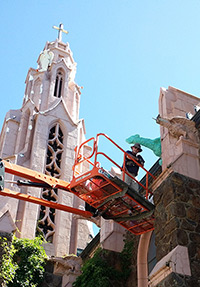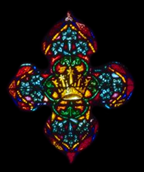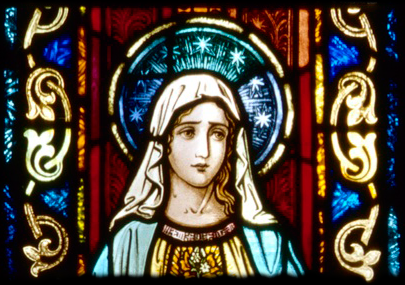of
BLESSED VIRGIN MARY
Chapel
then do what's possible; and
suddenly you are doing the impossible.
- St. Francis of Assisi
 Charles Kibby, CGI Preservation,
Charles Kibby, CGI Preservation, Los Angeles, CA
GARGOYLE MOLDS & TOWER WINTERIZATION
STAINED GLASS WINDOW INSPECTION
RECOMMENDATIONS - Phase III - Future Work
Gargoyle Molds & Tower Winterization
In August 2015, rubber molds of the gargoyles were made for future replication. Temporary waterproofing was applied to winterize raw concrete surfaces on the tower to prevent excessive water penetration of the structure.

After masking off nearby surfaces, Steven Grant of CGI Preservation applies green rubber mold compound to both a left-facing and right-facing gargoyle. The channel in the top of the gargoyle shows the gargoyles were originally designed as functional drain spouts for the rain gutter system.


Once the rubber compound dries, a white plaster top coat is applied. When dry, the form is removed.


All of the gargoyles, reportedly designed by M. J. Riordan based on local fauna, are severely damaged. Many are missing. During remediation efforts, both in April and August 2015, a gargoyle head came off. These photos show the same pair of gargoyles 6 months apart.


White elastomeric paint was applied as temporary winterization of the raw concrete.

STAINED GLASS WINDOW INSPECTION
Stained glass window restoration expert Adamm Gritlefeld of Adamm’s Gallery, Santa Monica, CA, made a detailed inspection of the beautiful Munich-style stained-glass windows, including missing or broken glass, sagging and bulging lead frames, and etched exterior storm shields. Many windows were found to be in remarkably good condition and only in need of cleaning and minor repairs. However, some were found to be seriously compromised and in need of immediate attention.

The largest window, The Assumption of the Blessed Virgin, is in critical condition. Others, such as St. Philomena, St. John Vianney, and St. Patrick, are in serious condition and require complete restoration (removal and re-leading). The Sacred Heart of Jesus, (left of the altar), has very loose reinforcing bars, which should be repaired as soon as possible.

The stained glass and decorative tracery of the cast stone on the main edifice, as seen in this early photograph, are barely visible behind the etched storm shields. During inspection, one shield was removed. The lead came was found to be in excellent condition.

One ventilator window in the choir loft – in critical condition - was crated and shipped for immediate restoration. The newly restored window can be seen in the lower left corner of The Assumption of the Blessed Virgin Mary.



RECOMENDATIONS: PHASE III - future work
Building:
Due to architectural and restoration complexities, it has been recommended a structural and material engineering firm with expertise in slate roofs and historical masonry be consulted for the following (estimated cost $35,000):
- an analysis of the chemical composition and compression strength of the decorative concrete to determine whether and how the existing masonry can best be preserved
- a recommendation of restoration methods and materials most cost effective and best suited to the site to avoid future problems
- an analysis of remaining building envelope, i.e. the slate roof, chimney, window and door openings, etc.
- restoration construction drawings and prioritization of restoration work (estimated cost $80,000 - $100,000)
Windows:
We have obtained three bids from various stained glass professionals, and continue to analyze the most appropriate long-term and cost-effective approach. We have an itemized list of recommended work for each window, and ranked priorities for restoration and repair, including replacement of the etched storm shields.

READ MORE: Phase III – Future Work & Funding

~ Ave Maria ~
